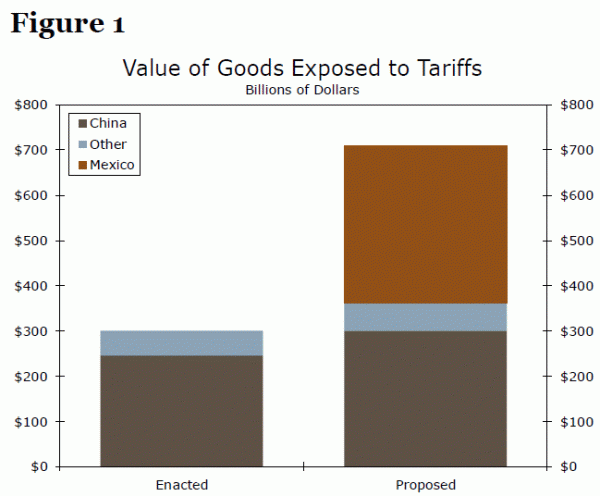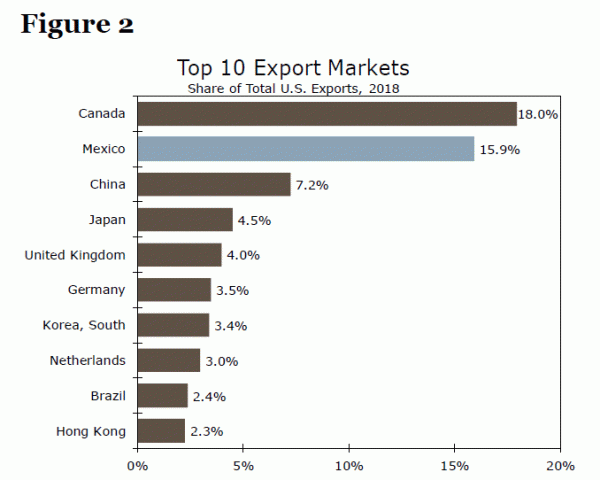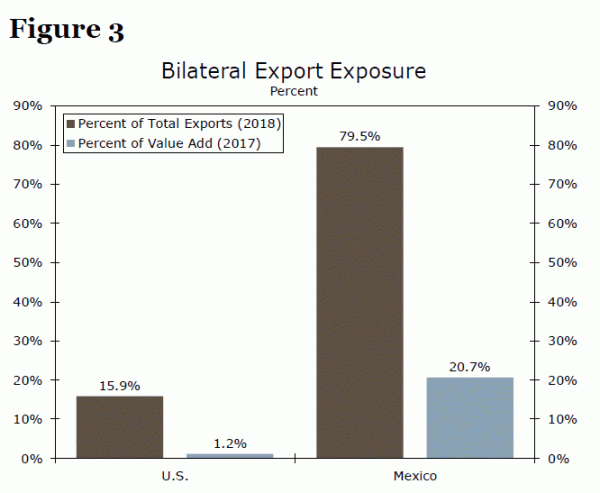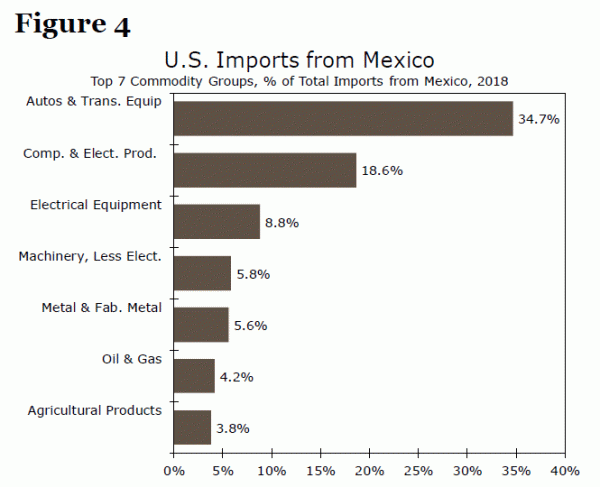U.S. and Mexico officials failed to reach a deal on tariffs at the conclusion of yesterday’s trade talks. Unless negotiators make major progress in the next few days, tariffs on goods coming into the United States from Mexico will be subject to a 5% tariff. Across the board, tariffs on Mexican goods would more than double the dollar value of goods currently subject to tariffs (Figure 1).
Unlike earlier tariffs with other countries, which were announced several weeks or months in advance, this new round against Mexico could go into effect this Monday, June 10, if a deal is not struck to demonstrate that Mexico is shutting down the path for illegal immigration into the United States. There is a built-in escalation of five percentage points each month until the tariff rate hits 25% on Monday, July 8.1
With each passing hour it appears less likely that there will be a deal in hand by Monday, but the fact that there is little appeal for these tariffs on either side of the aisle suggests Mexican tariffs could be short-lived. This special report puts the issue in context by evaluating the importance of Mexico as a trading partner to the United States and considers potential implications for this new front in the trade war.
By itself, a trade war with Mexico would not plunge the U.S. economy into recession. Still this spat with Mexico is not the only iron in the fire at the moment; cumulative effects add up. Also, Mexico is our second largest export market (Figure 2) and vital to a number of industries, none more so than the auto sector. Comprising roughly a third of all goods coming from Mexico, the auto sector is a key area of vulnerability in any sustained trade dispute with Mexico. For reasons that will become clear in a moment it is likely these figures substantially underestimate the importance of the auto sector. There are also greater risks for border states, which conduct a larger share of trade than the national average, as well as for states that depend on auto manufacturing, as supply chain disruptions could weigh on production and output.
Numbers to Put the Mexican Trade Relationship in Context
Trade with Mexico is essential to the vitality of the U.S. economy. Of all the goods imported into the United States last year, Mexico was second only to China with a 13.6% share. On the export side, China is less critical, coming in third on the list of export partners with just a 7.2% share of U.S. exports in 2018 (Revisit Figure 2).
By itself, a trade war with Mexico would not plunge the economy into recession. Exports to Mexico comprise only 1.2% of value added in the U.S. economy (Figure 3). The United States exports more to Mexico than to any other country except Canada, but still the share of total U.S. exports is just 15.9%. A big number, but it pales in comparison to the 79.5% share of Mexican exports that went to the United States in 2018. So at least in terms of the bilateral trade relationship, Mexico has more to lose than the United States.
The magnitude of the relationship, however, implies that if tariffs on Mexican goods were to go through, it would mark the biggest escalation yet in the ongoing trade war. If you add up the dollar value of all of the goods currently subject to tariffs, the totals is about $300 billion. The proposed tariffs on Mexico would affect an additional $346 billion of goods coming into the United States. This is more than just a new front; it is a more than doubling of the trade war in one shot (Revisit Figure 1).
Integrated Supply Chains
A key reason for the close relationships between the three North American economies are the integrated supply chains that have evolved in a number of key manufacturing industries since NAFTA went into effect in the early 1990s (Figure 4). Those close relationships and integrated supply chains blur the lines in tallying the share of imports. This is particularly true in the auto sector, where in the course of the manufacturing process a vehicle can cross international borders multiple times.
Consider a pair of vehicles from Honda, the HR-V and the Fit. The versions of these subcompact crossover vehicles for sale in the U.S. market are produced in Guanajuato, Mexico, but they share some chassis and body components with the popular Honda CR-V, which is produced in Ontario, Canada; East Liberty, Ohio and Greensburg, Indiana. Due to the multiple border crossings of parts and components for these vehicles, it is a difficult to dial in the precise impact by country within North American.
Research conducted by American University takes on this thorny issue by considering seven location variables including profit margin, labor and research and development to score specific automobile models and estimate what percent of a given vehicle is made in a given location.2
According to that methodology, the 2018 Honda HR-V is 30% Mexican-made, and 20% U.S. & Canadian-made. The 2018 Honda Fit is 45% Mexican-made and 20% U.S. & Canadian-made.
The point here is that even Mexican-made vehicles can have a significant share of manufacturing activity that occurs within the United States. The inverse is also true. Quintessentially American-made vehicles rely on parts production in Mexico. The Ford F-150 is 15% Mexican-made, and 44% of the Chevy Silverado comes from Mexico.
The deep interconnectedness of the auto sector means the supply chain disruptions from tariffs directed against Mexico could cause plenty of harm to U.S. business interests as well. Unlike the Chinese tariffs, which find at least some support among congressional leaders from both parties, the tariffs threatened against Mexico have engendered the rare rebuke of the president’s policies from GOP leadership in Congress along with the more predictable pushback from Democratic party leaders. For these reasons, we would anticipate it being difficult for the tariffs against Mexico to have a long shelf life.
Conclusion
It may not pay to play the long game on this one. We do not consider ourselves political analysts but there does not seem to be much support for these policies on either side of the aisle. Still, that may not prevent the tariffs from going into effect next week or escalating in subsequent weeks. Should these measures go into effect, and if our analysis about the interconnectedness of the American and Mexican economies is right, the economic pain they will cause, particularly in the auto sector, will likely make this a politically untenable plan in the longer run.
1 This action is under the authority granted in the International Emergency Economic Powers Act. See the “Statement from the President Regarding Emergency Measures to Address the Border Crisis” (May 30, 2019) for more detail.
2 Made in America Auto Index, Research by Frank DuBois, American University, Washington, D.C.


















